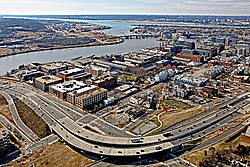
Back Washington Vlootwerf Afrikaans Washington Navy Yard Catalan Washington Navy Yard German Washington Navy Yard Esperanto Astillero Naval de Washington Spanish Washingtonin laivastotukikohta Finnish Washington Navy Yard French Washington Navy Yard ID Washington Navy Yard Italian ワシントン海軍工廠 Japanese
| Washington Navy Yard | |
|---|---|
| Part of Naval Support Activity Washington | |
| Southeast Washington, D.C. in the United States | |
 An aerial view of the Washington Navy Yard (established 1799), on the confluence of the Anacostia River (Eastern Branch) of the Potomac River, during 2021 | |
 | |
| Coordinates | 38°52′24″N 76°59′49″W / 38.87333°N 76.99694°W |
| Type | Naval support base |
| Site information | |
| Owner | U.S. Department of Defense (1947 to present) U.S. Department of the Navy (1799-1947) |
| Operator | United States Navy |
| Controlled by | Naval District Washington |
| Condition | Operational |
| Website | Official website |
| Site history | |
| Built | 1799 |
| In use | 1799 – present |
| Events |
|
| Garrison information | |
| Current commander | CAPTAIN Mark C. Burns |
| Official name | Washington Navy Yard |
| Designated | 19 June 1973 |
| Designated | 11 May 1976 |
| Reference no. | 73002124 |
| Areas of significance |
|
| Architect | Benjamin Latrobe et al. |
| Architect | |
| Designated | 8 November 1964[1] |
The Washington Navy Yard (WNY) is a ceremonial and administrative center for the United States Navy, located in the federal national capital city of Washington, D.C. (federal District of Columbia). It is the oldest shore establishment / base of the United States Navy, established 1799, situated along the north shore of the Anacostia River (Eastern Branch of the Potomac River) in the adjacent Navy Yard neighborhood of Southeast, Washington, D.C.
Formerly operating as a shipyard since the end of the 18th century / beginning of the 19th century, and ordnance plant, the yard currently serves as home to the Chief of Naval Operations (CNO), commanding the U.S. Navy, and is headquarters for the several military agencies and commands of: Naval Sea Systems Command, Naval Reactors, Naval Facilities Engineering Systems Command, Naval History and Heritage Command, Navy Installations Command, the National Museum of the United States Navy, the U.S. Navy Judge Advocate General's Corps, Marine Corps Institute, the United States Navy Band, and other more classified facilities.
In 1998, the yard was also listed as a Superfund site by the U.S. Environmental Protection Agency due to the extreme environmental contamination over its two and a quarter centuries existence.[2]
- ^ "District of Columbia Inventory of Historic Sites" (PDF). DC.GOV – Office of Planning. State Historic Preservation Office, D.C. Office of Planning. September 30, 2009. p. 171. Archived (PDF) from the original on October 1, 2020. Retrieved May 23, 2023.
- ^ U.S. EPA. "Washington Navy Yard". Superfund Information Systems: Site Progress Profile. Archived from the original on June 16, 2011. Retrieved July 18, 2011.


